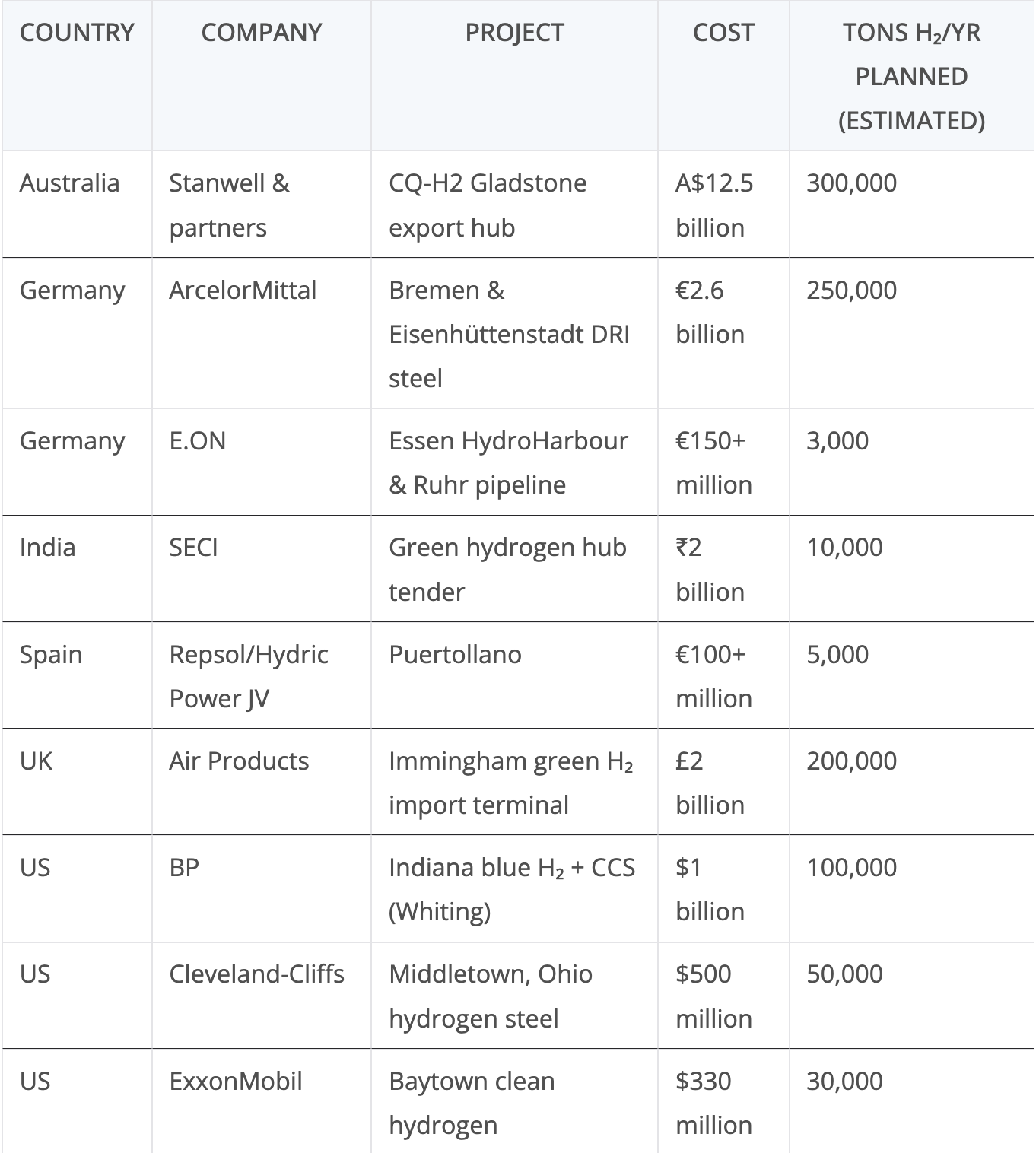The last 30 days marked a particularly rough period for hydrogen advocates, with a striking series of cancellations and project halts around the globe. The cumulative scale of these decisions underscores how challenging and economically vulnerable the hydrogen-for-energy sector has become. Over the span of approximately four weeks, projects valued at tens of billions in multiple countries have collapsed or been shelved indefinitely, erasing significant planned hydrogen production capacity. These reversals are not merely isolated incidents. They represent a broader recognition by industry leaders and governments that hydrogen, particularly for transportation and energy export, is confronting fundamental economic and technical barriers that optimism alone cannot overcome.
Here’s a structured summary table with estimated hydrogen production values (annual tons), based on typical scale for projects of similar size and stated goals from public plans:

Total estimated annual H₂ production capacity canceled: ~1 million tons/year
Australia’s high-profile CQ-H2 green hydrogen export project at Gladstone became the most notable casualty at the start of July. Originally slated as a AUD$12.5 billion (US$8.13 billion) venture aimed at providing substantial hydrogen exports to Japan and South Korea, the project quickly unraveled when Stanwell Corporation withdrew support, citing ballooning costs and questionable market viability. Gladstone was positioned to become Australia’s hydrogen export flagship, but now serves as a stark symbol of hydrogen’s broader economic uncertainties. The cancellation eliminated planned annual hydrogen production of several hundred thousand tons, dealing a severe blow to Queensland’s ambitions to become a renewable energy export powerhouse.
It’s in this context that other Australian news is of interest. Fortescue recently pulled back from hydrogen with significant retrenchment and leadership changes in its hydrogen group. In May, roughly 90 positions in hydrogen-related roles across Perth and Gladstone were eliminated as the company refocused away from large-scale manufacturing toward research and development aimed at improving efficiency and reducing costs. Mark Hutchinson, CEO of Fortescue Hydrogen Systems, retired ahead of his 65th birthday after less than two years in the position, transitioning to a senior adviser role with marketing responsibilities. Cameron Smith, who previously led the hydrogen systems division, also departed amid these cuts. CEO Dino Otranto has now absorbed operational responsibility for hydrogen and electrification, while Agustin “Gus” Pichot, formerly head of global growth, took on the role of CEO Growth and Energy effective July 1. These changes reflect a significant recalibration, abandoning the earlier ambitious target of producing 15 million tons of hydrogen per year by 2030, in favor of a more cautious, research-driven approach amid weaker-than-expected market conditions.
Germany faced similarly harsh realities. ArcelorMittal, one of Europe’s largest steel producers, abandoned plans to convert its Bremen and Eisenhüttenstadt plants to hydrogen-based direct reduced iron and electric arc furnaces. Each of these green steel plants was to cost roughly €1.3 billion (US$1.52 billion), with projected hydrogen consumption amounting to hundreds of thousands of tons annually. ArcelorMittal cited soaring energy costs and insufficient economic incentives as key reasons for pulling the plug.
This abandonment was part of what prompted my recent assessment of different new steel approaches, which found that hydrogen-based iron and steelmaking remains fundamentally disadvantaged compared to emerging alternatives. With hydrogen typically priced around $5 to $8 per kilogram, even optimistic scenarios of $3 to $4 per kilogram still render it uneconomical for steel production at scale. Direct reduction processes relying on hydrogen incur substantial energy losses through electrolysis, storage, compression, and handling, inevitably inflating steel production costs beyond competitive thresholds. Molten oxide electrolysis, on the other hand, becomes viable with electricity at $0.03 to $0.05 per kWh, delivering steel at costs approaching $170 to $250 per ton assuming it reaches full commercialization.
Similarly, biomethane-based direct reduction combined with carbon capture can be economically attractive where biomass is abundant and sequestration sites are nearby. Flash ironmaking paired with natural gas and carbon capture achieves steel costs comfortably below $200 per ton. Hydrogen is thus hampered not by technological maturity, but by structural economic limitations that alternative processes inherently avoid. For steel decarbonization strategies, it’s clear the future belongs to methods that offer fundamentally superior cost structures and energy efficiencies.
Germany’s struggles did not end there. E.ON, a major utility, canceled its planned 20-megawatt green hydrogen facility in Essen and also withdrew from the regional H₂ Ruhr pipeline initiative. These actions further reduced Europe’s planned hydrogen capacity and infrastructure, again driven by unmanageable economic realities.
In India, the Solar Energy Corporation of India (SECI) abruptly terminated its ₹2 billion (US$23.3 million) green hydrogen hub tender in early July. The project’s cancellation included the refunding of all tender fees, highlighting how rapidly India has reversed course amid growing doubts about hydrogen’s economic competitiveness. While India’s government had previously heralded hydrogen as a key component of its decarbonization strategy, economic pragmatism now appears to have overshadowed earlier enthusiasm.
Spain’s once-promising Repsol and Hydric Power joint venture at Puertollano similarly collapsed. The green hydrogen project, valued at more than €100 million (US$117 million), faced immediate shelving in July due to both technical and economic infeasibility. Spain had touted Puertollano as a cornerstone of its green hydrogen ambitions, yet the project’s failure signals severe underlying structural problems in hydrogen deployment even within supportive policy environments.
The United Kingdom also saw major hydrogen initiatives retreat. Air Products scrapped its £2 billion (US$2.72 billion) green hydrogen import terminal project in Immingham on the Humber Estuary. The facility, initially seen as critical for the UK’s hydrogen supply and industrial decarbonization plans, fell victim to policy uncertainty and inadequate governmental financial backing. This cancellation underscores the risks inherent in hydrogen infrastructure investments that rely heavily on continuous policy and subsidy support.
In the United States, the picture was equally bleak. BP indefinitely paused its blue hydrogen and carbon capture project at its refinery in Whiting, Indiana. Once considered a potential multi-billion-dollar flagship for blue hydrogen in America’s Midwest, the project stalled amid rising skepticism over carbon capture’s viability and shifting political priorities. Cleveland-Cliffs canceled its $500 million hydrogen-based steel facility planned for Middletown, Ohio, depriving the industry of another major hydrogen consumer. ExxonMobil’s $330 million clean hydrogen initiative at its Baytown, Texas refinery was also halted after federal funding evaporated under new political realities, leaving substantial planned hydrogen production capacity stranded.
Taken collectively, these project cancellations represent billions of dollars in lost investment and a million tons of planned hydrogen production capacity that will not materialize. The ripple effect on hydrogen-based transportation and infrastructure projects is significant. Without reliable, economically viable hydrogen supplies, many downstream initiatives from heavy trucks and marine vessels to industrial heat and green steelmaking face substantially increased operational risks and reduced credibility. The cancellations of June and July reinforce what has become increasingly clear throughout 2025: hydrogen’s economic model, particularly for transportation and export, remains fragile and heavily dependent on external subsidies, stable policy frameworks, and optimistic assumptions about market uptake.

It’s in context of these billions in evaporating hydrogen plays that I updated my hydrogen deathwatch list today, finding more firms that had given up the ghost, either through complete fiscal meltdown or by quietly pivoting away from hydrogen. Over 20% of the firms on my list, 33 of 162, have either gone into receivership or pivoted to something useful.
These widespread reversals should serve as a critical wake-up call for policymakers and industrial strategists still vainly hoping to leverage hydrogen as a central pillar of energy transition efforts. Electrification and battery storage solutions, by contrast, continue gaining momentum, attracting investment and achieving reliable cost reductions year over year. Hydrogen proponents must grapple realistically with the fundamental economics at play.
Remember, this is only four weeks worth of failures. They’ve been ongoing since the beginning of 2025, with Michael Liebreich putting up #HydrogenSouffle LinkedIn posts almost daily. BNEF just reported on its database of hydrogen contracts and still only 13% of the 299 hydrogen contacts in their database have firm off takers. This is a radically small number of contracts and a homeopathic number of firm agreements given the massive ambitions for 2030, as well as the massive announcements of the past few years.
This disastrous month underscores that promises alone cannot sustain a hydrogen economy. Realism, pragmatism, and a clear-eyed approach to economically sustainable energy solutions must now prevail if meaningful progress is to be made. That means hydrogen will be reserved for what it is absolutely required for, almost entirely industrial feedstocks, and nothing else.
Sign up for CleanTechnica’s Weekly Substack for Zach and Scott’s in-depth analyses and high level summaries, sign up for our daily newsletter, and follow us on Google News!
Whether you have solar power or not, please complete our latest solar power survey.
Have a tip for CleanTechnica? Want to advertise? Want to suggest a guest for our CleanTech Talk podcast? Contact us here.
Sign up for our daily newsletter for 15 new cleantech stories a day. Or sign up for our weekly one on top stories of the week if daily is too frequent.
CleanTechnica uses affiliate links. See our policy here.
CleanTechnica’s Comment Policy

